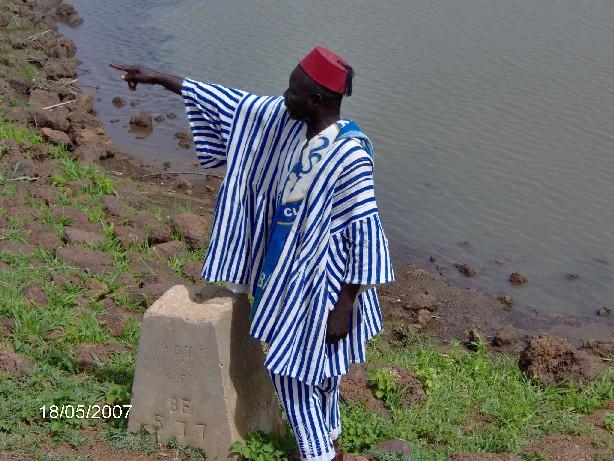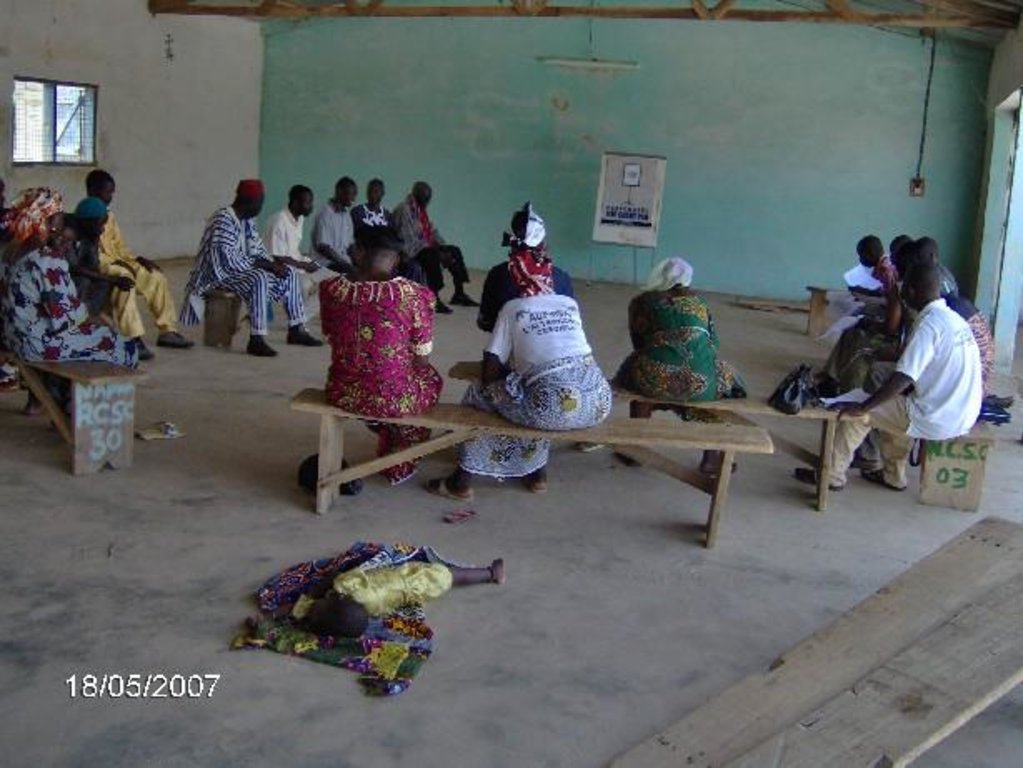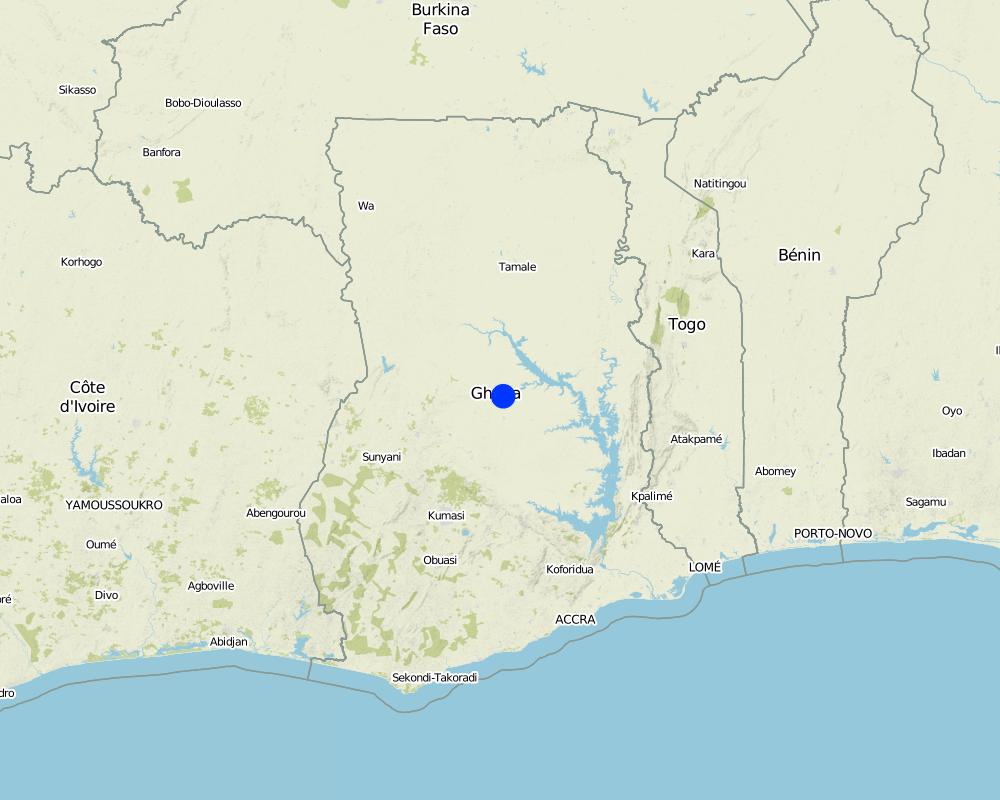Participatory Negotiated Territorial Development [غانا]
- تاريخ الإنشاء:
- تحديث:
- جامع المعلومات: Philippe Zahner
- المحرر: –
- المُراجع: Fabian Ottiger
approaches_2570 - غانا
عرض الأقسام
توسيع الكل طي الكل1. معلومات عامة
1.2 تفاصيل الاتصال بالأشخاص الرئيسيين لمصدر المعلومات والمؤسسات المعنية بتقييم وتوثيق النهج
متخصص في الإدارة المستدامة للأراضي:
Groppo Paolo
paolo.groppo@fao.org
FAO
Rome
إيطاليا
متخصص في الإدارة المستدامة للأراضي:
Cenerini Carolina
carolina.cenerini@fao.org
FAO
Rome
إيطاليا
اسم المؤسسة (المؤسسات) التي سهلت توثيق/تقييم النهج (إذا كان ذلك على صلة)
Swiss Agency for Development and Cooperation (DEZA / COSUDE / DDC / SDC) - سويسرااسم المؤسسة (المؤسسات) التي سهلت توثيق/تقييم النهج (إذا كان ذلك على صلة)
Food and Agriculture Organization of the United Nations (FAO) - إيطاليا1.3 الشروط المتعلقة باستخدام البيانات الموثقة من خلال WOCAT
يوافق جامع المعلومات والشخص (لاشخاص) الرئيسي لمصدر المعلومات على الشروط المتعلقة باستخدام البيانات الموثقة من خلال WOCAT:
نعم
2. وصف نهج الإدارة المستدامة للأراضي
2.1 وصف موجز للنهج
Participatory Negotiated Territorial Development (PNTD) is a rural development approach developed by FAO.
2.2 وصف تفصيلي للنهج
وصف تفصيلي للنهج:
Aims / objectives: It offers a structure to build consensus among individual communities and development partners on natural resources/territorial management and development issues. PNTD facilitates consensus based planning within a team that represents different actors at different levels, including sector offices / technical services (agriculture, environment, etc.) and NGOs (involved in community-based rural development) at district/ department/ municipality level; and traditional authorities, user groups and associations at community/ village level.
Methods: During the diagnostic phase of the PNTD process, local territorial issues are analysed based on the viewpoints of the different actors and on a historical analysis. This step contributes to a coherent, shared understanding of the territorial system, thus providing the basis for collective agreements on development. These are referred to as Social Territorial Agreements. They are based on negotiation within the PNTD team. Main activities of PNTD include: (1) Facilitation of the planning process; (2) Provision of technical expertise; (3) Linkages to relevant institutions; (4) Technical advisory to assess viability and costs of joint development proposals; (5) Reporting back to communities and provision with final plans and resource maps; (6) Signing of ‘Social Territorial Agreements’ and endorsement by local government; (7) Establishment of a joint monitoring and evaluation system; and (8) Follow-up meetings between government institutions and NGOs.
Other important information: Independent external support by territorial facilitators is essential to assist in various aspects of the process. A PNTD approach was piloted within a project in the Onchocerciasis (riverblindess) Freed Zone along the Burkina Faso-Ghana border. This newly opened zone lacked a well defined, accepted management structure to support the development process, while cross-border aspects further complicated development, requiring cooperation among the communities and development partners from both countries. The PNTD team was supported by facilitators from the Netherlands Development Organisation (SNV). The team’s capacity to carry out inclusive planning processes has improved significantly, in terms of proposal development, negotiation and consensus building, and in placing the findings of the diagnostic phase in the larger geographical context. Joint development plans were elaborated and agreed upon from the perspective of the communities. FAO has been supporting the exercise through technical backstopping.
2.3 صور عن النهج
2.5 البلد/المنطقة/المواقع التي تم تطبيق النهج فيها
البلد:
غانا
المنطقة/الولاية/المحافظة:
Ghana and Burkina Faso
Map
×2.7 نوع النهج
- قائم على مشروع/برنامج
2.8 الغايات/الأهداف الرئيسية للنهج
The Approach focused mainly on SLM with other activities (a road to link two communities directly)
Testing a PNTD approach for local (transboundary) territorial planning; Refining the methodological process; Preparing a joint development plan for the two areas in Ghana and Burkina Faso
The SLM Approach addressed the following problems: Limited commitment from central governments; Cross-border planning proved to be considerably more expensive than regular planning activities
3. المشاركة وأدوار الأطراف المعنية
3.1 أصحاب المصلحة المعنيون بالنهج وأدوارهم
- مستخدمو الأراضي المحليون/المجتمعات المحلية
Community leaders
- منظمة غير حكومية
SNV
- الحكومة الوطنية (المخططون، صانعو القرار)
- منظمة دولية
3.2 انخراط مستخدمي الأراضي المحليين/المجتمعات المحلية في المراحل المختلفة للنهج
| انخراط مستخدمي الأراضي المحليين/المجتمعات المحلية | حدد من شارك وصف الأنشطة | |
|---|---|---|
| المبادرة/التحفيز | غير موجود | |
| التخطيط | غير موجود | |
| التنفيذ | غير موجود | |
| الرصد/التقييم | غير موجود | |
| Research | غير موجود |
4. الدعم الفني وبناء القدرات وإدارة المعرفة
4.1 بناء القدرات/التدريب
هل تم تقديم التدريب لمستخدمي الأراضي / الأطراف المعنيين الآخرين؟:
نعم
حدد من تم تدريبه:
- مستخدمو الأراضي
- موظفون ميدانيون/ مستشارون
شكل التدريب:
- في العمل
المواضيع المغطاة:
Training focused on: (1) the PNTD process and its application in the context of cross-border natural resource management; (2) PRA tools relevant to the diagnostic phase; (3) participatory resource mapping (a tool to support the negotiation on development proposals)
4.2 خدمة استشارية
هل يملك مستخدمو الأراضي وصولا إلى خدمة استشارية؟:
نعم
وصف/تعليقات:
This approach focuses on establishing and maintaining social dialogue within the territory and restructuring and/or strengthening territorial institutions.
5. التمويل والدعم المادي الخارجي
5.2 الدعم المالي/المادي المقدم لمستخدمي الأراضي
هل حصل مستخدمو الأراضي على دعم مالي/ مادي لتنفيذ التقنية/ التقنيات؟:
كلا
5.3 إعانات لمدخلات محددة (بما في ذلك العمالة)
- غير موجود
إذا كان العمل من قبل مستخدمي الأراضي مدخلاً جوهريًا، فهل كان:
- تطوعي
التعليقات:
No subsidies were given. Labour was not rewarded and inputs were not financed by the project.
5.4 الائتمان
هل تم توفير ائتمان في إطار نهج أنشطة الإدارة المستدامة للأراضي؟:
كلا
6. تحليل الأثر والتصريحات الختامية
6.1 آثار النهج
هل ساعد النهج مستخدمي الأراضي على تنفيذ وصيانة تقنيات الإدارة المستدامة للأراضي؟:
- لا
- نعم، قليلا
- نعم، باعتدال
- نعم، إلى حد كبير
improved soil conservation and livestock rearing
Did other land users / projects adopt the Approach?
- لا
- نعم، قليلا
- نعم، باعتدال
- نعم، إلى حد كبير
Invoked a high level of interest within the targeted communities; increased active participation, planning and consensus building capacity at community level
6.2 المحفز الرئيسي لقيام مستخدمي الأراضي بتنفيذ الإدارة المستدامة للأراضي
- الوجاهة والضغط الاجتماعي/التماسك الاجتماعي
avoiding potential transboundary conflicts
- الوعي البيئي
improving natural resources and land management
6.3 استدامة أنشطة النهج
هل يمكن لمستخدمي الأراضي المحافظة على استدامة ما تم تنفيذه من خلال النهج (بدون دعم خارجي)؟:
- نعم
إذا كانت الإجابة بنعم، صف كيف:
The PNTD-approach has shown applicability. Yet, there are some aspects which need to be considered: (Local) governments need to take ownership of the cross-border planning and development processes. This could be realized by structuring external support differently: (1) Local government (districts, municipalities) supported by NGO’s are responsible to carry out all activities; (2) External (project) support focuses on overall coordination, the provision of technical advice, the provision of op
6.4 نقاط قوة/مزايا النهج
| نقاط القوة/ المزايا/ الفرص من وجهة نظر جامع المعلومات أو غيره من الاشخاص الرئيسيين لمصدر المعلومات |
|---|
| Provides a suitable framework for cross-border planning in the West African context |
| PNTD process raised the level of participation of local government institutions and NGO’s in a negotiated territorial development process through the PNTD team which comprised technical staff of these organizations. |
| PNTD enabled (and stimulated) the communities on both sides of the border to interact and joint development plans were elaborated and agreed upon from the perspective of the communities. |
| Looking beyond community boundaries, and consensus building between communities and stakeholders were new aspects of planning to the team members |
6.5 نقاط الضعف/ العيوب في المنهج وطرق التغلب عليها
| نقاط الضعف/ المساوىء/ المخاطر من وجهة نظر جامع المعلومات أو غيره من الاشخاص الرئيسيين لمصدر المعلومات | كيف يمكن التغلب عليها؟ |
|---|---|
| It took time for team members to grasp the conceptual approach of PNTD. They were used to working within individual communities, and if they were involved in planning then mostly at a diagnostic level. | |
| Language problems required almost continuous translation, and thus effectively doubling the time required | recruitment of linguistic mediator(s) need to be considered in the project budget |
7. المراجع والروابط
7.1 طرق جمع/مصادر المعلومات
- زيارات ميدانية، مسوحات ميدانية
- مقابلات مع مستخدمي الأراضي
7.2 المراجع للمنشورات المتاحة
العنوان، المؤلف، السنة، النظام القياسي الدولي لترقيم الكتب ISBN:
FAO. 2005. An approach to rural development: Participatory and Negotiated Territorial Development (PNTD). Rural Development Division, FAO. OFZ Project (Socio Economic Development Programme for the Transborder Onchocerciasis Freed Zone of Burkina Faso and Ghana)
العنوان، المؤلف، السنة، النظام القياسي الدولي لترقيم الكتب ISBN:
SNV Burkina Faso - SNV Ghana. 2007. X-border Participatory, Negotiated, Territorial Development (PNTD) – pilot phase report.
الروابط والوحدات المواضيعية
توسيع الكل طي الكلالروابط
لا يوجد روابط
الوحدات المواضيعية
لا يوجد وحدات مواضيعية






